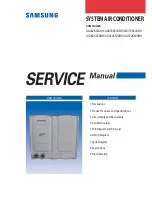
9
Water connections
Refer to the certified dimensional drawings for the sizes and
positions of all water inlet and outlet connections. The water
pipes must not transmit any radial or axial force to the heat
exchangers or any vibration to the pipework or building.
The water supply must be analysed and appropriate filtering,
treatment, control devices, isolation and bleed valves and
circuits built in, as necessary. Consult either a water treatment
specialist or appropriate literature on the subject.
Operating precautions
The water circuit should be designed to have the least number
of elbows and horizontal pipe runs at different levels. Below
the basic checks to be done (see also the illustration of a typical
hydraulic circuit below).
•
Note the water inlets and outlets of the heat exchangers.
•
Install manual or automatic air purge valves at all high
points in the water circuit.
•
Use an expansion chamber or an expansion/relief valve to
maintain pressure in the system.
•
Install water thermometers in both the entering and
leaving water connections close to the evaporator.
•
Install drain valves at all low points to allow the whole
circuit to be drained.
•
Install stop valves, close to the evaporator, in the entering
and leaving water lines.
•
Use flexible connections to reduce the transmission of
vibration to the pipework.
•
Insulate all pipework, after testing for leaks, both to
reduce thermal leaks and to prevent condensation.
•
Cover the insulation with a vapour barrier.
Water-loop connections
Make the water-side heat exchanger connections, using
appropriate hardware capable of ensuring water-tightness of
threaded unions.
The illustration below shows a typical hydraulic circuit.
IMPORTANT: In winter frost can cause cooler damage. Use
appropriate methods of protection, according to the climatic
conditions:
•
Add ethylene glycol.
•
Increase the insulation thickness.
•
Do not de-energize the cooler heaters.
•
For a prolonged shutdown period, drain the water from
the cooler and replace it with ethylene glycol. At the
beginning of the next cooling season, refill the cooler and
add the recommended inhibitor.
Auxiliary equipment should be installed according to
basic refrigeration and piping practices, especially with
respect to minimum and maximum cooler water flow
rates, which must be between the values given in the
tables in the 'Application data' section.
Typical hydraulic circuit diagram
Control valve
Air vent
Flow switch
Flexible connection
Heat exchanger
Fill valve
Expansion tank
Filter
Buffer tank
Drain
Pressure tap
Thermostat sleeve


































